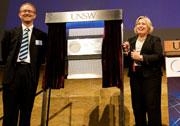New age of space research
Australia's space capabilities have received a significant boost with the opening of the country's first centre for satellite and space engineering.
Australia's space capabilities have received a significant boost with the opening of the country's first centre for satellite and space engineering.

Australia's space capabilities have received a significant boost with the opening of the country's first centre for satellite and space engineering at UNSW.
The new Australian Centre for Space Engineering Research (ACSER) will develop technologies for satellite navigation; Earth Observation applications such as monitoring of disasters, climate change and mine subsidence; national security; and space vehicle engineering.
NASA space shuttle astronaut Jan Davis was the guest of honour at the centre's launch.
ACSER Director, Associate Professor Andrew Dempster of the School of Surveying and Spatial Information Systems, said Australia lacks its own satellites at a time when the global space industry was expanding rapidly.
In an article published on the opinion website The National Times, Associate Professor Dempster has outlined the role ACSER can play in building up Australia's space technology capabilities.
"Interest in space is booming as the number of satellites being launched escalates, and that increase will affect everything from smartphones and cars to innovations in industry, mining, agriculture, communication and security," he said.
"At ACSER we are developing systems to enable real-time, highly accurate mapping of the Earth's surface, and technologies to allow new satellite navigation systems to communicate with each other, improving service accuracy and availability.
"Australia was the fourth country in the world to launch a satellite - we did that in the 1960s - but we've lagged ever since. We will be working to establish an Australian presence in the space industry," he said.
ACSER combines the expertise of researchers in the UNSW faculties of Engineering and Science, and UNSW@ADFA (Australian Defence Force Academy).
Media contact: Peter Trute, UNSW Media Unit, 9385 1933